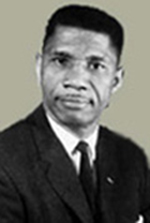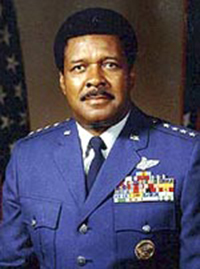
Medgar Evers
Source: State Dept.
Black Americans who had used non-violent methods to protest military segregation during World War II continued to use the same tactics they had learned in the military to protest segregation in the broader American community after they returned home. In 1945, for example, black veterans met in Atlanta, Georgia, and agreed to cooperate in a search for a "full share of democracy." 100 black veterans marched on the courthouse in Birmingham, Alabama, in 1946, complaining that they had been denied the right to register to vote. A veteran who attempted to register to vote in Mississippi was beaten.1
For some veterans, their homecoming was part of a direct path to the civil rights movements of the 1950s and 1960s. One young veteran led a group of black veterans to the Decatur, Mississippi, courthouse in July of 1946 to vote; when the group was turned away, the young veteran, Medgar Evers, took his first steps toward committing his life to black equality. Hosea Williams, a key member of Martin Luther King's staff, protested after he was refused a drink of water at a bus station snack bar while in uniform after the War; he was beaten until observers thought he was dead and spent eight weeks in the hospital recovering.2

WWII Veteran Hosea WIlliams, Rev. Jesse Jackson, Rev. Dr. Martin Luther King, and WWII Veteran Rev. Ralph Abernathy in Memphis shortly before Dr. King's death.
Source: AP
At the end of World War II men like the Freeman pilots returned to a number of civilian communities. It is difficult to say how many communities the veterans influenced with ideas about non-violent protest developed in the military during World War II. The examples of Evers and Williams, however, suggests that two major groups that would contribute to the desegregation efforts of the 1950s and 1960s, such as Evers's NAACP and Williams's Southern Christian Leadership Conference, included men who would have known that disciplined, non-violent protest had been effective during the War.

General Daniel "Chappie" James Jr.
Source: Air Force Museum
There seems little question that many of the men who participated in non-violent protest during the War were later leaders in their communities. Coleman Young, an organizer of the events at Freeman Field, would later be the mayor of Detroit. William Coleman, another leader at Freeman, would be Secretary of Transportation in the Ford Administration. Also present at Freeman during the protests were Daniel "Chappie" James, who would be the United States Air Forces's first black four-star general, and Tom Bradley, later the mayor of Los Angeles. Given these examples, it seems reasonable to conclude that the veterans of World War II were men of influence in a variety of communities after the War. World War II changed American race relations and led to the protest movements of the 1950s and 1960s.3
One historian has written that
[i]n many ways, the disciplined, non-violent action taken by the . . . officers of the 477th was a forerunner of the non-violent US civil rights struggle of the 1950s and 1960s.4
